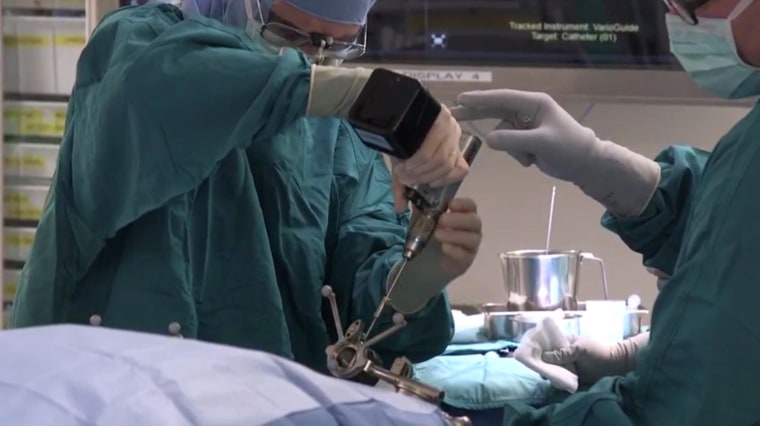A modified version of the polio vaccine, infused straight into aggressive brain tumors, helped some patients live for years longer than they normally would have, doctors reported Tuesday.
It’s no miracle cure — only about 20 percent of patients with gliomas were helped — but some are alive six years later, the team reported in the New England Journal of Medicine.
It’s a hopeful enough finding to move forward and test the vaccine in more people, the team at the Duke University School of Medicine said.
“It’s very unusual, almost unprecedented to get this kind of long-term survival,” neurologist Dr. Darell Bigner, who led the study team, told NBC News.
The Duke team tested 61 glioma patients over five years. They all had grade IV gliomas, a group of brain tumors that includes glioblastoma.
These patients have a “dismal” prognosis, the Duke team wrote in the New England Journal of Medicine. “There is currently no effective therapy.”
Standard treatment of brain tumors includes surgery if the tumor is somewhere reachable; chemotherapy; and radiation. But if the tumor is aggressive, it’s usually fatal.
“These are people who failed everything,” Bigner said. “Virtually all patients, no matter what you treat them with, are dead within in two years.”
About a third of all brain tumors are gliomas, according to the National Brain Tumor Society. About 80,000 people a year are diagnosed with a brain tumor, and about 24,000 of those are malignant. “The average survival rate for all malignant brain tumor patients is only 34.7 percent,” the group says.
But there’s evidence that some viruses can home in on tumors and kill them. It’s not clear why, but viruses can also make tumors more visible to the immune system.
The team at Duke worked with the National Cancer Institute to design and manufacture a modified version of polio vaccine virus.
Polio viruses are attracted to nerve cells — that’s why they cause paralysis.
The medical team used polio viruses already weakened and altered for use in polio vaccines, and genetically engineered them to carry parts of a common cold virus, called a rhinovirus, known to be attracted to glioma cells.
They infused various doses into the tumors of the 61 glioma patients.
“We inject the virus directly into brain tumors and it kills all the tumor cells it comes in contact with,” Bigner said. “The most important thing is, it sets up a secondary immune response and really destroys the distant tumor cells.”
'I'm amazed'
The very first patient was Stephanie Hopper, who was diagnosed with a glioblastoma when she was just 20.
“I was throwing up and I had a headache behind my eye. I didn’t even know I had cancer until after the surgery to remove the tumor,” Hopper told NBC News. “It was the size of a tennis ball.”

Hopper was a little wary of being infused with a polio virus, but was ready to try. It worked. She’s still alive, married and working as a nurse in Greenville, South Carolina, more than six years later.
“I’m amazed,” she said. “I never really felt like I was going die. I think my life was just put on hold.”
After three years, 21 percent of patients were still alive, the team reported. That compares to 20 months or less on average for similar patients.
One patient had a hemorrhage and 19 percent had a notable adverse event, the team reported. More than half had headaches and half had hemiparesis, weakness or paralysis on one side of the body. Another 45 percent had a seizure. More than a quarter had aphasia -- brain damage that makes speaking and communication difficult.
The patient who had the hemorrhage suffered aphasia but was still alive more nearly five years later. Two patients died during the trial.
“The nature of the treatment causes side-effects,” Bigner said. “The virus infection causes a very potent inflammation response and that response causes brain swelling.”
The cancer drug Avastin is used in low doses to control the swelling, the team said.
It’s not clear why just one in five patients benefits, said Dr. Annick Desjardins, who worked on the study team.

“Similar to many immunotherapies, it appears that some patients don’t respond for one reason or another, but if they respond, they often become long-term survivors,” Desjardins said. “The big question is, how can we make sure that everybody responds?”
The Duke team compared their 61 volunteers to similar past patients who did not get the treatment. All but one of those previous patients died after an average of 11 months. Just 14 percent were still alive two years after diagnosis and 4 percent were alive three years later.
But the 21 percent or so of patients helped by the vaccine all survived at least three years.
As of March of this year, eight patients had no evidence of the tumors growing any more and two had no evidence of a brain tumor at all.


